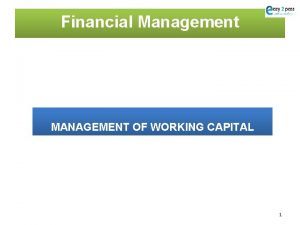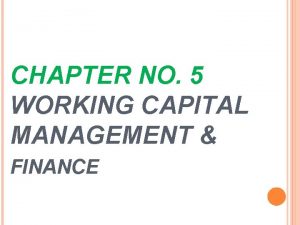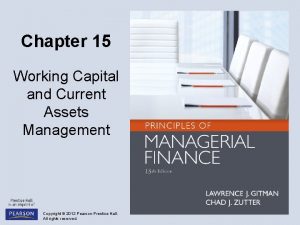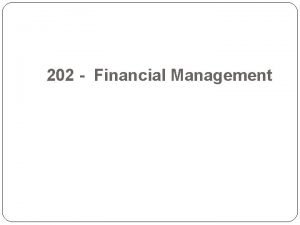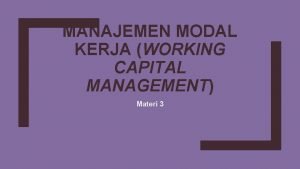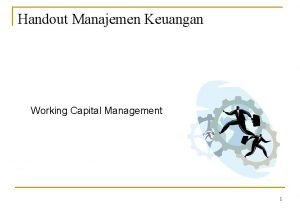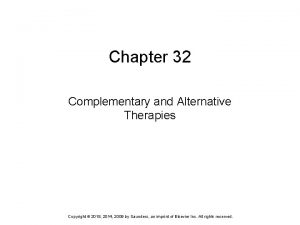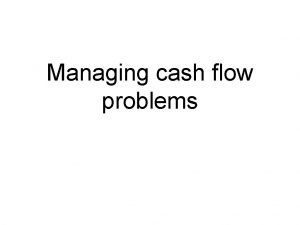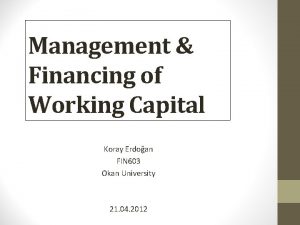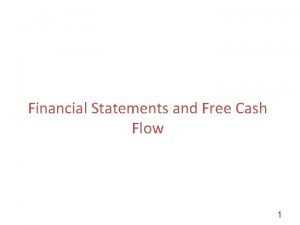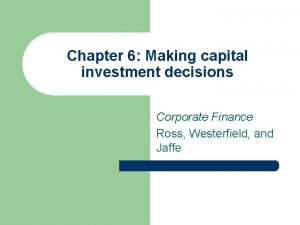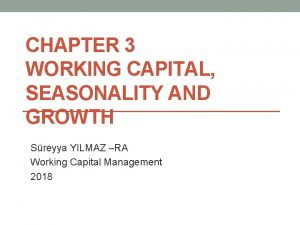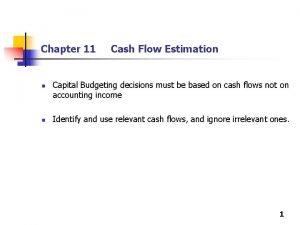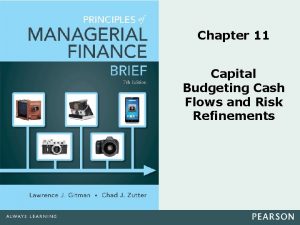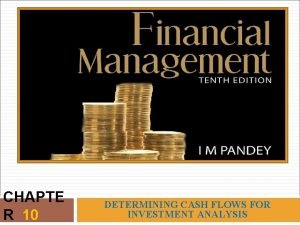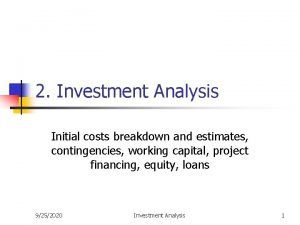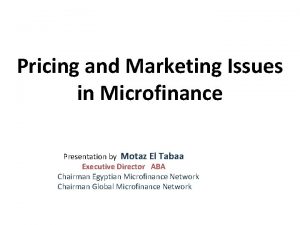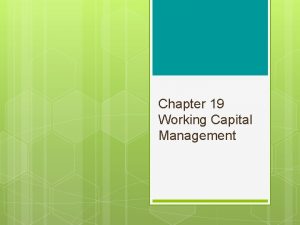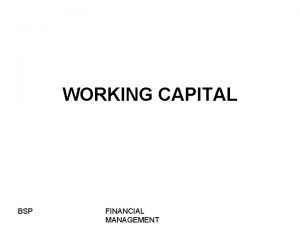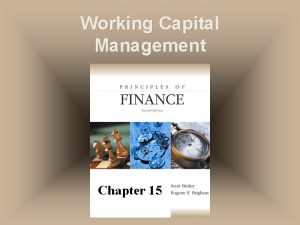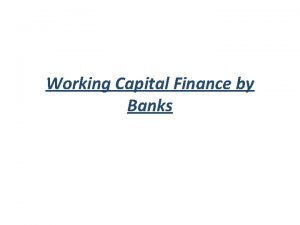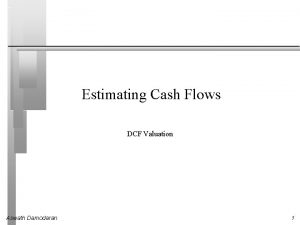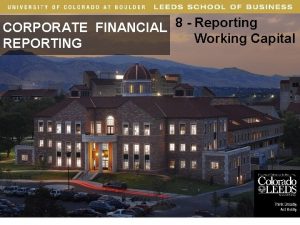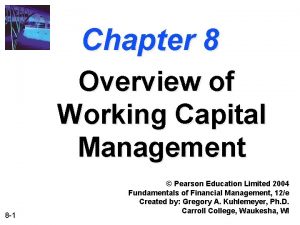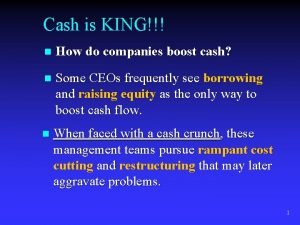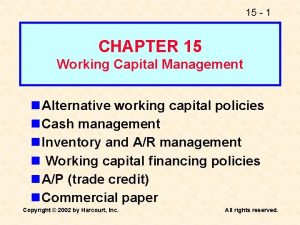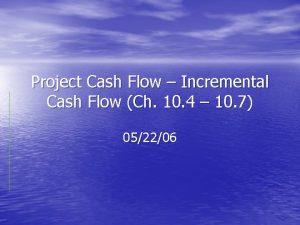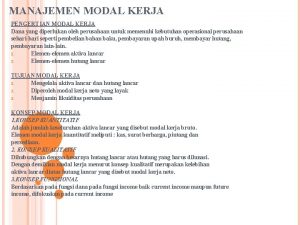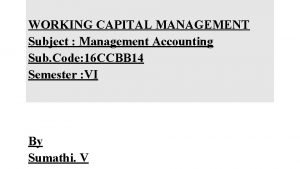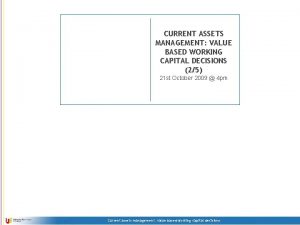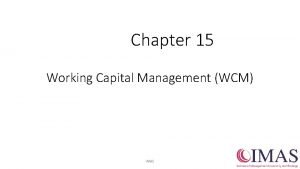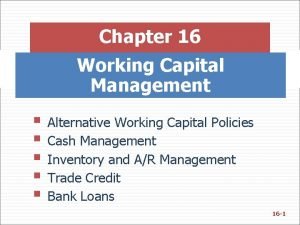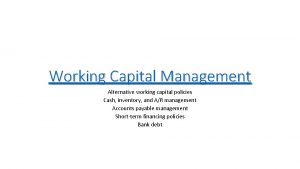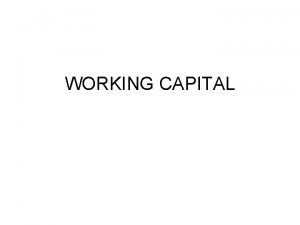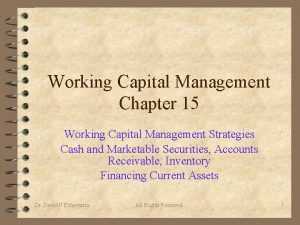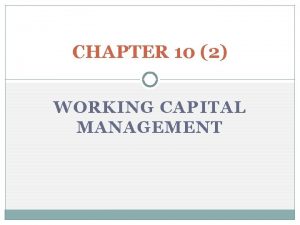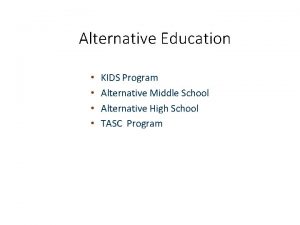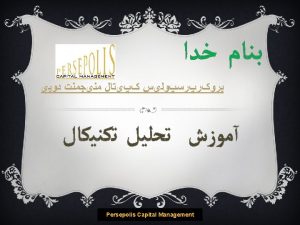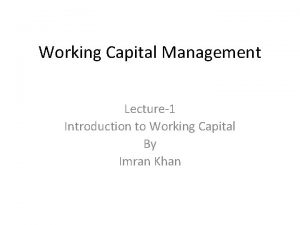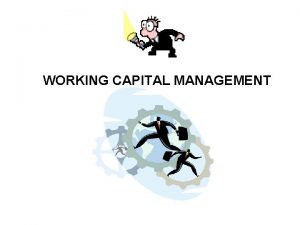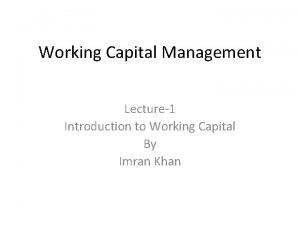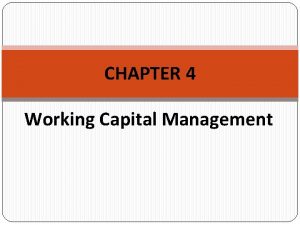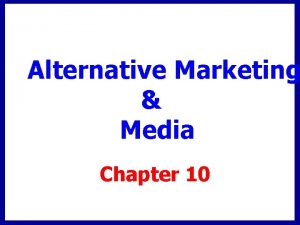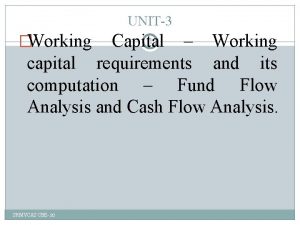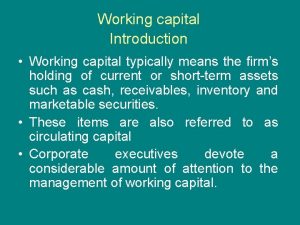Chapter 16 Working Capital Management ALTERNATIVE WORKING CAPITAL

























































- Slides: 57

Chapter 16 Working Capital Management § § § ALTERNATIVE WORKING CAPITAL POLICIES CASH MANAGEMENT INVENTORY AND A/R MANAGEMENT TRADE CREDIT BANK LOANS Dr. Mohammad Alkhamis Kuwait University - College of Business Administration 1

Working Capital Terminology § Working capital – current assets. § Net working capital – current assets minus current liabilities. § Net Operating Working Capital (NOWC) – Net Working Capital without the Notes Payable § Working capital policy – deciding the level of each type of current asset to hold, and how to finance current assets. § Working capital management – controlling cash, inventories, and A/R, plus short-term liability management. © 2016 Cengage learning Kuwait University - College of Business Administration 2

Selected Ratios for SKI Inc. Current ratio Debt/Assets Turnover of cash & securities Days sales outstanding Inventory turnover Fixed assets turnover Total assets turnover Profit margin Return on equity © 2016 Cengage learning SKI 1. 75 x 58. 76% 16. 67 x 45. 63 4. 82 x 11. 35 x 2. 08 x 2. 07% 10. 45% Ind Avg 2. 25 x 50. 00% 22. 22 x 32. 00 7. 00 x 12. 00 x 3. 50% 21. 00% Kuwait University - College of Business Administration 3

How does SKI’s working capital policy compare with its industry? § Working capital policy is reflected in the current ratio, turnover of cash and securities, inventory turnover, and days sales outstanding. § These ratios indicate SKI has large amounts of working capital relative to its level of sales. § SKI is either very conservative or inefficient. © 2016 Cengage learning Kuwait University - College of Business Administration 4

Is SKI inefficient or conservative? § A conservative (relaxed) policy may be appropriate if it leads to greater profitability. § However, SKI is not as profitable as the average firm in the industry. § This suggests the company has excessive working capital. © 2016 Cengage learning Kuwait University - College of Business Administration 5

Working Capital Investment Policies § Relaxed – high level of current assets § low total asset turnover lower ROE. § Restricted – constrained level of current assets § low level of assets high total assets turnover ratio high ROE. § also exposes the firm to risks because shortages can lead to work stoppages and unhappy customers. § Moderate – an in-between policy © 2016 Cengage learning Kuwait University - College of Business Administration 6

Working Capital Financing Policies § Companies go through cycles and seasons… § Permanent Current Assets: Current assets that a firm must carry even at the trough of its cycles. § Temporary Current Assets: Current assets that fluctuate with seasonal or cyclical variations in sales. § Current Assets Financing Policy: The way current assets are financed. © 2016 Cengage learning Kuwait University - College of Business Administration 7

Working Capital Financing Policies § Moderate – Match the maturity of the assets with the maturity of the financing. § Aggressive – Use short-term financing to finance permanent assets. § Subject to dangers from loan renewal as well as problems with rising interest rates. However, short-term interest rates are generally lower than long-term rates. § Conservative – Use permanent capital for permanent assets and temporary assets. © 2016 Cengage learning Kuwait University - College of Business Administration 8

Moderate Financing policy © 2016 Cengage learning Kuwait University - College of Business Administration 9

Moderately aggressive Financing Policy $ Temp. C. A. S-T Loans Perm C. A. Fixed Assets L-T Fin: Stock, Bonds, Spon. C. L. Years Lower dashed line would be more aggressive. © 2016 Cengage learning Kuwait University - College of Business Administration 10

Conservative Financing Policy $ Marketable securities Perm C. A. Zero S-T Debt L-T Fin: Stock, Bonds, Spon. C. L. Fixed Assets Years © 2016 Cengage learning Kuwait University - College of Business Administration 11

Cash Conversion Cycle § The cash conversion cycle focuses on the length of time between when a company makes payments to its creditors and when a company receives payments from its customers. © 2016 Cengage learning Kuwait University - College of Business Administration 12

Cash Conversion Cycle § Inventory Conversion Period: The average time required to sell inventory. For a manufacturing firm, it would be the time required to convert raw materials into finished goods and then to sell them. § DSO or ACP: The length of time customers are given to pay for goods following a sale. § Payable Deferral Period: The average length of time between the purchase of materials and the payment of cash for them. © 2016 Cengage learning Kuwait University - College of Business Administration 13

Dr. Mohammad Alkhamis Kuwait University - College of Business Administration 14

Cash Conversion Cycle Why care about CCC? § The shorter the cash conversion cycle, the better because that will lower interest charges. § Note that if the firm could sell goods faster, collect receivables faster, or defer its payables longer without hurting sales or increasing operating costs, its CCC would decline, its interest charges would be reduced, and its profits and stock price would be improved © 2016 Cengage learning Kuwait University - College of Business Administration 15

Cash Conversion Cycle © 2016 Cengage learning Kuwait University - College of Business Administration 16

Cash Conversion Cycle © 2016 Cengage learning Kuwait University - College of Business Administration 17

Dr. Mohammad Alkhamis Kuwait University - College of Business Administration 18 18

Dr. Mohammad Alkhamis Kuwait University - College of Business Administration 19

Its COGS represents 80% of sales. Dr. Mohammad Alkhamis Kuwait University - College of Business Administration 20 20

Dr. Mohammad Alkhamis Kuwait University - College of Business Administration 21

Can you have a negative cash conversion cycle? Dr. Mohammad Alkhamis Kuwait University - College of Business Administration 22

Cash Budget § Forecasts cash inflows, outflows, and ending cash balances. § Used to plan loans needed or funds available to invest. § Can be daily, weekly, or monthly, forecasts. § Monthly for annual planning and daily for actual cash management. © 2016 Cengage learning Kuwait University - College of Business Administration 23

Cash Budget § Target Cash Balance: The desired cash balance that a firm plans to maintain in order to conduct business. § it plans to borrow to meet this target or to invest surplus funds if it generates more cash than is needed. © 2016 Cengage learning Kuwait University - College of Business Administration 24

SKI’s Cash Budget for January and February © 2016 Cengage learning Kuwait University - College of Business Administration 25

SKI’s Cash Budget © 2016 Cengage learning Kuwait University - College of Business Administration 26

How could bad debts be worked into the cash budget? § Collections would be reduced by the amount of the bad debt losses. § For example, if the firm had 3% bad debt losses, collections would total only 97% of sales. § Lower collections would lead to higher borrowing requirements. © 2016 Cengage learning Kuwait University - College of Business Administration 27

Analyze SKI’s Forecasted Cash Budget § Cash holdings will exceed the target balance for each month, except for October and November. § Cash budget indicates the company is holding too much cash. § SKI could improve its EVA by either investing cash in more productive assets, or by returning cash to its shareholders. § Economic Value Added = EBIT(1 -T)-WACC(Capital employed) © 2016 Cengage learning Kuwait University - College of Business Administration 28

Why might SKI want to maintain a relatively high amount of cash? § If sales turn out to be considerably less than expected, SKI could face a cash shortfall. § A company may choose to hold large amounts of cash if it does not have much faith in its sales forecast, or if it is very conservative. § The cash may be used, in part, to fund future investments. © 2016 Cengage learning Kuwait University - College of Business Administration 29

Cash Budget Example. . © 2016 Cengage learning Kuwait University - College of Business Administration 30

Dr. Mohammad Alkhamis Kuwait University - College of Business Administration 31

Cash & Marketable Securities § What does “Cash” on a balance sheet usually mean? § “cash” as reported on balance sheets generally includes shortterm securities, which are also called “cash equivalents. ” § Why would firms hold marketable securities? § Operating short-term securities to provide liquidity and funding for operations § Other short-term securities: excess securities just in case © 2016 Cengage learning Kuwait University - College of Business Administration 32

Cash & Marketable Securities § Currency § Demand deposits § How to optimize your level of demand deposits? § § § Hold marketable securities rather than demand deposits for liquidity Borrow on short notice through lines of credit Forecast payments and receipts better Use credit cards, debit cards, and wire transfers Synchronize cash inflows and outflows § Marketable Securities © 2016 Cengage learning Kuwait University - College of Business Administration 33

Inventory Costs § Types of inventory costs § Carrying costs – storage and handling costs, insurance, property taxes, depreciation, and obsolescence. § Ordering costs – cost of placing orders, shipping, and handling costs. § Costs of running short – loss of sales or customer goodwill, and the disruption of production schedules. § Reducing inventory levels generally reduces carrying costs, increases ordering costs, and may increase the costs of running short. © 2016 Cengage learning Kuwait University - College of Business Administration 34

Is SKI holding too much inventory? § SKI’s inventory turnover (4. 82 x) is considerably lower than the industry average (7. 00 x). § The firm is carrying a lot of inventory per dollar of sales. § By holding excessive inventory, the firm is increasing its costs, which reduces its ROE. § Moreover, this additional working capital must be financed, so EVA is also lowered. © 2016 Cengage learning Kuwait University - College of Business Administration 35

If SKI reduces its inventory, without adversely affecting sales, what effect will this have on the cash position? § Short run: Cash will increase as inventory purchases decline. § Long run: Company is likely to take steps to reduce its cash holdings and increase its EVA. © 2016 Cengage learning Kuwait University - College of Business Administration 36

Do SKI’s customers pay more or less promptly than those of its competitors? § SKI’s DSO (45. 6 days) is well above the industry average (32 days). § SKI’s customers are paying less promptly. § SKI should consider tightening its credit policy in order to reduce its DSO. © 2016 Cengage learning Kuwait University - College of Business Administration 37

Elements of Credit Policy 1. Credit Period – How long to pay? Shorter period reduces DSO and average A/R, but it may discourage sales. 2. Cash Discounts – Lowers price. Attracts new customers and reduces DSO. 3. Credit Standards – Tighter standards tend to reduce sales, but reduce bad debt expense. Fewer bad debts reduce DSO. 4. Collection Policy – How tough? Tougher policy will reduce DSO but may damage customer relationships. © 2016 Cengage learning Kuwait University - College of Business Administration 38

Does SKI face any risk if it tightens its credit policy? § Yes, a tighter credit policy may discourage sales. § Some customers may choose to go elsewhere if they are pressured to pay their bills sooner. § SKI must balance the benefits of fewer bad debts with the cost of possible lost sales. © 2016 Cengage learning Kuwait University - College of Business Administration 39

If SKI reduces its DSO without adversely affecting sales, how would this affect its cash position? § Short run: If customers pay sooner, this increases cash holdings. § Long run: Over time, the company would hopefully invest the cash in more productive assets, or pay it out to shareholders. Both of these actions would increase EVA. © 2016 Cengage learning Kuwait University - College of Business Administration 40

Dr. Mohammad Alkhamis Kuwait University - College of Business Administration 14 -41 41

What is trade credit? § Trade Credit: Debt arising from credit purchases and recorded as an account payable by the buyer. § Trade credit is often the largest source of short-term credit, especially for small firms. § Spontaneous, easy to get, but cost can be high. § Why is it costly? © 2016 Cengage learning Kuwait University - College of Business Administration 42

Terms of Trade Credit § A firm buys $3, 000 net ($3, 030, 303 gross) on terms of 1/10, net 30. § The firm can forego discounts and pay on Day 40, without penalty. © 2016 Cengage learning Kuwait University - College of Business Administration 43

Breaking Down Trade Credit § Payables level, if the firm takes discounts § Payables = $8, 219. 18(10) = $82, 192 § Payables level, if the firm takes no discounts § Payables = $8, 219. 18(40) = $328, 767 § Credit breakdown © 2016 Cengage learning Kuwait University - College of Business Administration 44

Nominal Cost of Trade Credit § The firm loses 0. 01($3, 030, 303) = $30, 303 of discounts to obtain $246, 575 in extra trade credit: r. NOM = $30, 303/$246, 575 = 0. 1229 = 12. 29% § The $30, 303 is paid throughout the year, so the effective cost of costly trade credit is higher. © 2016 Cengage learning Kuwait University - College of Business Administration 45

Nominal Cost of Trade Credit Formula © 2016 Cengage learning Kuwait University - College of Business Administration 46

Effective Cost of Trade Credit § Periodic rate = 0. 01/0. 99 = 1. 01% § Periods/year = 365/(40 – 10) = 12. 1667 § Effective cost of trade credit © 2016 Cengage learning Kuwait University - College of Business Administration 47

Dr. Mohammad Alkhamis Kuwait University - College of Business Administration 48

Bank Loans § What is a promissory note? § A document specifying the terms and conditions of a loan, including the amount, interest rate, and repayment schedule. © 2016 Cengage learning Kuwait University - College of Business Administration 49

Promissory note features § § § Amount. Maturity. Interest rate. Interest only versus amortized. Frequency of interest payments. Add-on loans. § Auto loans and other consumer installment loans are generally set up on an “add-on basis, ” which means that interest charges over the life of the loan are calculated and then added to the face amount of the loan. § Collateral. § Restrictive covenants. § Loan guarantees. © 2016 Cengage learning Kuwait University - College of Business Administration 50

Line of Credit Vs. Revolving Credit § Line of Credit § An arrangement in which a bank agrees to lend up to a specified maximum amount of funds during a designated period. § Informal and nonbinding § Revolving credit Agreement. § A formal, committed line of credit extended by a bank or another lending institution. § Important difference: The bank has a legal obligation to honor a revolving credit agreement, and it receives a commitment fee. Neither the legal obligation nor the fee exists under informal lines of credit. © 2016 Cengage learning Kuwait University - College of Business Administration 51

Bank Loans § The firm can borrow $100, 000 for 1 year at an 8% nominal rate. § Interest may be set under one of the following scenarios: § Simple monthly interest § Installment loan, add-on, 12 months © 2016 Cengage learning Kuwait University - College of Business Administration 52

Simple Interest § © 2016 Cengage learning Kuwait University - College of Business Administration 53

Simple Interest § © 2016 Cengage learning Kuwait University - College of Business Administration 54

Add-on Interest § § § Interest = 0. 08 ($100, 000) = $8, 000 Face amount = $100, 000 + $8, 000 = $108, 000 Monthly payment = $108, 000/12 = $9, 000 Avg loan outstanding = $100, 000/2 = $50, 000 Approximate cost = $8, 000/$50, 000 = 16. 0% To find the appropriate effective rate, recognize that the firm receives $100, 000 and must make monthly payments of $9, 000 (like an annuity). © 2016 Cengage learning Kuwait University - College of Business Administration 55

Add-on Interest From the calculator output below, we have: r. NOM = 12 (0. 012043) = 0. 1445 = 14. 45% EAR = (1. 012043)12 – 1 = 15. 45% INPUTS 12 N OUTPUT © 2016 Cengage learning I/YR 100 -9 0 PV PMT FV 1. 2043 Kuwait University - College of Business Administration 56

Other Current Liabilities § Accruals § Continually recurring short-term liabilities, especially accrued wages and accrued taxes § Secured loans § Loans backed by collateral © 2016 Cengage learning Kuwait University - College of Business Administration 57
 Fixed capital and working capital
Fixed capital and working capital Operating cycle formula
Operating cycle formula Long term financing
Long term financing Zero working capital
Zero working capital Management of current assets
Management of current assets What is working capital in financial management
What is working capital in financial management Contoh soal penentuan kebutuhan modal kerja
Contoh soal penentuan kebutuhan modal kerja Working capital management
Working capital management Smart work vs hard work
Smart work vs hard work Hot and cold working process
Hot and cold working process Hot working and cold working difference
Hot working and cold working difference Machining operations
Machining operations Pengerjaan panas dan dingin
Pengerjaan panas dan dingin Chapter 32 complementary and alternative therapies
Chapter 32 complementary and alternative therapies Chapter 11 complementary and alternative medicine
Chapter 11 complementary and alternative medicine Ideal working capital turnover ratio
Ideal working capital turnover ratio Insufficient cashflow
Insufficient cashflow Working capital
Working capital Fcf nopat
Fcf nopat Working capital investment example
Working capital investment example Negative working capital
Negative working capital Operating net working capital formula
Operating net working capital formula Ocf formula
Ocf formula Capital budgeting
Capital budgeting Incremental cash flows definition
Incremental cash flows definition Working capital breakdown
Working capital breakdown Working capital life cycle
Working capital life cycle Working capital ratio
Working capital ratio Working capital
Working capital Trade working capital
Trade working capital Bülent aybar
Bülent aybar Working capital managemetn
Working capital managemetn Working capital terminology
Working capital terminology Mpbf refers to
Mpbf refers to Dcf aswath
Dcf aswath Working capital reporting
Working capital reporting Hedging approach of working capital
Hedging approach of working capital Boost working capital
Boost working capital Working capital financing policy
Working capital financing policy Incremental cash flow
Incremental cash flow Pengertian modal kerja
Pengertian modal kerja Contoh manajemen modal kerja
Contoh manajemen modal kerja Sub working capital
Sub working capital Working capital decisions
Working capital decisions Ready imas
Ready imas Source of capital reserve
Source of capital reserve Multinational cost of capital and capital structure
Multinational cost of capital and capital structure Difference between capital reserve and reserve capital
Difference between capital reserve and reserve capital Basle ii
Basle ii Regulatory capital vs economic capital
Regulatory capital vs economic capital Variable capital examples
Variable capital examples Multinational cost of capital and capital structure
Multinational cost of capital and capital structure Capital allocation line vs capital market line
Capital allocation line vs capital market line Top management and middle management
Top management and middle management Top management middle management first line management
Top management middle management first line management Middle level management
Middle level management Chapter 12 inventory management
Chapter 12 inventory management Working with young children/answer key chapter 1
Working with young children/answer key chapter 1


